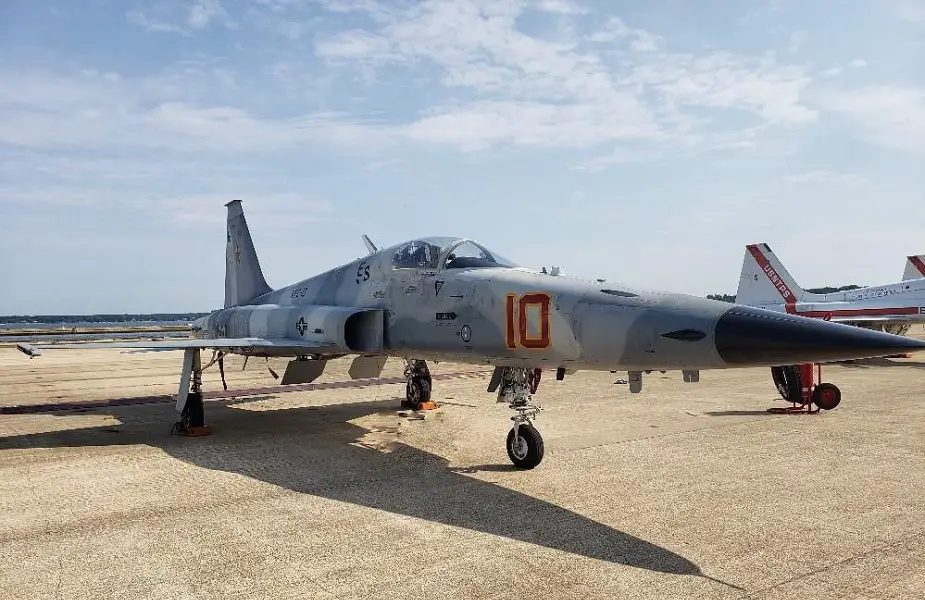Breaking news
US Navy upgrades adversary tactical fighter improving safety, readiness.
The Navy’s Specialized and Proven Aircraft program office (PMA-226) recently delivered the first F-5N aircraft to Naval Air Station Patuxent River, Md. to begin ground and flight test of the F-5 block upgrade prototype project. Aligned with the Navy’s strategic imperative of increasing capability and enhancing lethality, the newly redesigned tactical fighters will include features found on modern aircraft that improve both safety and readiness.
Follow Air Recognition on Google News at this link
 The Navy delivered the first F-5N aircraft to Naval Air Station Patuxent River, Md. to begin ground and flight test of the F-5 block upgrade prototype project. The results of these tests will provide data to be used as a major element in the conversion of the 16 F-5E and six F-5F aircraft the Navy recently acquired from the Swiss Air Force (Picture source: US Navy)
The Navy delivered the first F-5N aircraft to Naval Air Station Patuxent River, Md. to begin ground and flight test of the F-5 block upgrade prototype project. The results of these tests will provide data to be used as a major element in the conversion of the 16 F-5E and six F-5F aircraft the Navy recently acquired from the Swiss Air Force (Picture source: US Navy)
The F-5 aircraft, performing for many years as a high altitude, high speed tactical fighter used by the Navy and Marine Corps as an adversary aggressor, lacks modern safety systems, avionics, and common tactical capabilities found in modern aircraft. This F-5N aircraft is one of three F-5Ns that will be used as prototypes of the modernized cockpit, avionics and supporting aircraft architecture. These upgrades improve safety, capability and reliability, while resolving increasing obsolescence issues.
Upon successful completion of test, the program office will use these upgrades as a major element in the conversion of the 16 F-5E and six F-5F aircraft the Navy recently acquired from the Swiss Air Force. The program office will convert these 22 aircraft under the Avionics Reconfiguration and Tactical Enhancement/Modernization for Inventory Standardization (ARTEMIS) program. PMA-226 successfully completed the independent logistics assessment for the ARTEMIS Program in June and anticipates reaching a Milestone C decision in early FY 2022.
“Constructive collaboration with our partners, the fleet, and the PMA-226 team drove mission success despite the technical, schedule and management challenges of integrating 21st century technology into a 1970’s airframe during the pandemic,” said Boyd Forsythe, PMA-226 adversary team lead.
The F-5 aircraft receiving the block upgrade prototype modifications will be designated F-5N+/F+. The potential risk of loss of a pilot and/or aircraft will be reduced by adding necessary instrumentation that provides air-to-ground warning, severe weather protection, and fuel level warnings. This upgrade will also add tactical capabilities designed to improve “friendly” force air-to-air training.
Given the significant use of commercial off the shelf components with well-defined maintenance and support equipment requirements for the block upgrade prototype configured aircraft, the product support strategy will be organizational level (O-level) to original equipment manufacturer. The block upgrade O-level preventive maintenance will consist of inspections, cleaning and scheduled maintenance tasks. Additionally, the O-level maintainers will load system software using currently fielded commercial off-the-shelf portable electronic maintenance aids.
“This program will provide modernized aircraft with exceptional avionics and tactical capabilities which are needed to allow pilots to practice the tactics and techniques employed against a near-peer threat. Delivery of these improvements will ensure realistic and relevant tactical training the pilots need to win in combat,” said Capt. Ramiro Flores, PMA-226 program manager.


























